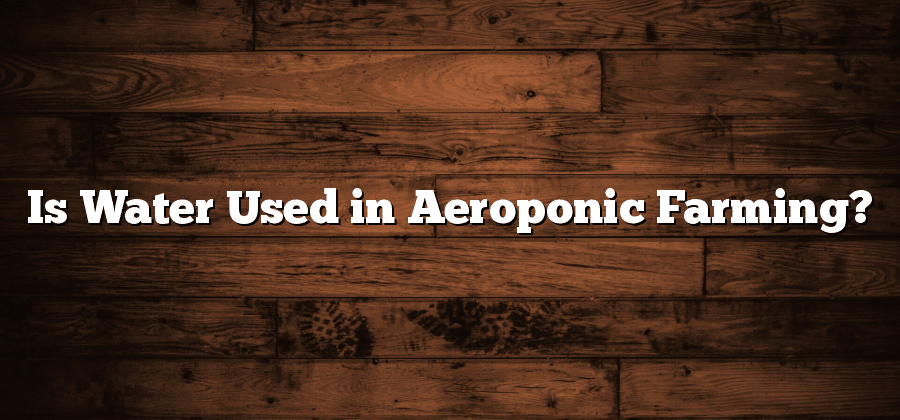Water: The Essential Resource for Aeroponic Farming
With the increasing global demand for sustainable and efficient agricultural practices, aeroponic farming has emerged as a viable solution. In this innovative method, plants are grown without the use of soil, with their roots suspended in air and misted with a nutrient-rich water solution. Water plays a crucial role in aeroponic systems, serving not only as a medium to deliver essential nutrients to the plants but also as a key factor in maintaining overall system health and productivity.
In aeroponic farming, water acts as a carrier of nutrients, ensuring that plants receive the necessary elements for growth and development. The nutrient solution, finely misted onto the suspended roots, provides access to oxygen, minerals, and other vital components that plants require for their survival. This efficient delivery system allows for increased nutrient uptake and absorption, ultimately leading to healthier and faster-growing crops. Moreover, the ability to tailor the composition of the nutrient solution allows farmers to optimize plant growth by providing the exact amounts and types of nutrients needed, resulting in higher yields and better quality produce.
Understanding the Basics of Aeroponic Farming
Aeroponic farming is a modern agricultural practice that has gained significant popularity in recent years. Unlike traditional farming methods that involve soil as the growth medium, aeroponics relies on air and water to provide plants with the necessary nutrients. In this system, plant roots are suspended in the air and misted with a nutrient-rich water solution, allowing for optimal nutrient absorption and enhanced plant growth.
One of the key advantages of aeroponic farming is its ability to maximize the use of limited resources, such as water. As water is the primary medium for delivering nutrients to the plants in this system, it is crucial to understand the role of water in aeroponics. Adequate hydration is essential for the plants to develop healthy roots, uptake nutrients, and thrive. However, it is crucial to strike a delicate balance in the amount of water provided, as excessive watering can lead to root rot and other issues. Therefore, understanding proper water management techniques is fundamental in achieving optimal results in aeroponic farming.
The Role of Water in Aeroponic Systems
Water plays a crucial role in aeroponic systems, serving as the essential resource for plant growth and development. In this innovative farming technique, water acts as the primary medium for delivering nutrients directly to the plant roots suspended in the air. Unlike traditional soil-based farming methods, aeroponic systems leverage water misting or spraying to provide the necessary hydration and nourishment to the plants.
Without water, aeroponic farming would not be possible. Water acts as the carrier for nutrients, facilitating their absorption by the plants. Additionally, it helps to maintain the optimal humidity levels within the system, creating a conducive environment for plant growth. As water is continuously sprayed or misted onto the roots, it provides a constant flow of nutrients, ensuring that the plants receive the necessary sustenance for their healthy development.
Water management becomes a critical aspect of aeroponic farming. It is important to monitor and control the water supply to ensure the right moisture levels for plant growth without causing waterlogging or dehydration. Additionally, the quality of water used in aeroponic systems should be carefully considered to prevent the buildup of contaminants or potential harm to the plants. Efficient water circulation systems and monitoring tools are integral to maintaining the proper balance and utilization of water in aeroponic farming, allowing for sustainable and successful plant cultivation.
Water Conservation in Aeroponic Farming
Water Conservation in Aeroponic Farming
Aeroponic farming is both an innovative and sustainable approach to cultivation. By utilizing a system that relies on misting water and nutrients directly onto the plant roots, it minimizes water usage compared to traditional soil-based farming methods. However, even with its water-saving advantages, water conservation remains a crucial aspect of aeroponic farming.
There are several strategies that farmers can employ to optimize water conservation in their aeroponic systems. Firstly, monitoring and controlling the water flow is essential. By closely monitoring the amount of water delivered to each plant, farmers can ensure that they are using only the necessary amount, preventing any excess water waste. Additionally, implementing automated systems that adjust water flow based on plant needs can further enhance water conservation efforts. Furthermore, utilizing high-efficiency nozzles and misters can improve water distribution, maximizing the effectiveness of each water droplet and reducing wastage.
Optimizing Water Usage in Aeroponic Farming
A key objective in aeroponic farming is to optimize water usage to ensure efficient and sustainable operations. As water scarcity becomes an increasingly prevalent concern, it becomes crucial for aeroponic farmers to adopt strategies that conserve water while maintaining the health and productivity of their crops.
One effective approach to optimize water usage is through the use of advanced irrigation systems. These systems are designed to deliver water and nutrients directly to the plant roots in a precise and controlled manner. By carefully regulating the amount and timing of water delivery, aeroponic farmers can minimize waste and ensure that each plant receives the necessary amount of hydration. Additionally, smart sensors can be integrated into the system to monitor soil moisture levels, allowing farmers to adjust the irrigation schedule accordingly and avoid overwatering. Such technological advancements not only save water but also contribute to the overall health and quality of plants grown aeroponically.






